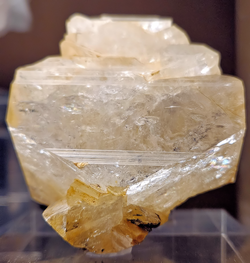Chemistry:Hyalophane
| Hyalophane | |
|---|---|
 Hyalophane crystal (Busovača, Bosnia and Herzegovina) | |
| General | |
| Category | Tectosilicate |
| Formula (repeating unit) | (K,Ba)[Al(Si,Al)Si 2O 8] |
| Crystal system | Monoclinic |
| Crystal class | Prismatic (2/m) (same H-M symbol) |
| Space group | C2/m |
| Unit cell | a = 8.52 Å, b = 12.95 Å, c = 7.14 Å; β = 116°; Z = 4 |
| Identification | |
| Formula mass | 302.06 g/mol |
| Color | Colorless, yellow, white, red |
| Crystal habit | Crystalline – fine – occurs as well-formed fine sized crystals; massive – uniformly indistinguishable crystals forming large masses |
| Twinning | Commonly simple twins according to the Carlsbad, Manebach, or Baveno laws |
| Cleavage | {001} perfect, {010} imperfect |
| Fracture | Conchoidal |
| Tenacity | Brittle |
| Mohs scale hardness | 6 – 6 1⁄2 |
| |re|er}} | Vitreous |
| Streak | White |
| Diaphaneity | Transparent to translucent |
| Specific gravity | 2.81 |
| Optical properties | Biaxial (-) |
| Refractive index | nα = 1.542, nβ = 1.545, nγ = 1.547 |
| Birefringence | δ = 0.005 |
| 2V angle | 48 – 79° |
| Dispersion | Weak |
| References | [1][2][3][4] |
Hyalophane or jaloallofane is a crystalline mineral, part of the feldspar group of tectosilicates. It is considered a barium-rich potassium feldspar.[5] Its chemical formula is (K,Ba)[Al(Si,Al)Si
2O
8], and it has a hardness of 6 to 6 1⁄2. The name hyalophane comes from the Greek hyalos, meaning "glass", and phanos meaning "to appear".[4]
An occurrence of hyalophane was discovered in 1855 in Lengenbach Quarry, Imfield, Binn valley, municipality of Binn, Canton of Valais, Switzerland . The mineral is found predominantly in Europe, with occurrences in Switzerland, Australia , Bosnia, Germany , Japan , New Jersey, and the west coast of North America.[4] Hyalophane may be found in manganese deposits in compact metamorphic zones.[6]
Hyalophane has a monoclinic crystallography, with cell properties a = 8.52 Å, b = 12.95 Å, c = 7.14 Å, and β = 116°. Optically, the material exhibits biaxial birefringence, with refractive index values of nα = 1.542, nβ = 1.545, and nγ = 1.547 and a maximum birefringence of δ = 0.005. It has weak dispersion and low surface relief.[1]
Hyalophane has sometimes been used as a gemstone.[7]
References
- ↑ 1.0 1.1 "Hyalophane". Hudson Institute of Mineralogy. http://www.mindat.org/min-1960.html. Retrieved 11 May 2016.
- ↑ "Hyalophane Mineral Data". http://webmineral.com/data/Hyalophane.shtml#.VzM6E4S4m00. Retrieved 11 May 2016.
- ↑ Hyalophane, Mineral Data Publishing, http://rruff.geo.arizona.edu/doclib/hom/hyalophane.pdf
- ↑ 4.0 4.1 4.2 "Hyalophane". Archived from the original on 2006-09-01. https://web.archive.org/web/20060901195438/http://www.museums.udel.edu/mineral/mineral_site/collection/alphabetical/H/hyalophane.html.
- ↑ "Hyalophane". Britannica Online Encyclopedia. http://www.britannica.com/eb/article-9041681/hyalophane.
- ↑ Deer, W. A.; Howie, R. A.; Zussman, J. (2001). Rock-Forming Minerals: Volume 4A: Framework Silicates: Feldspars (2nd ed.). Geological Society of London. p. 928. ISBN 9781862390812. https://books.google.com/books?id=Sv4hjoj_M7IC. Retrieved 2 December 2016.
- ↑ Schumann, Walter (1977). Gemstones of the World. p. 56. ISBN 978-1454909538. https://books.google.com/books?id=V9PqVxpxeiEC.
 |

